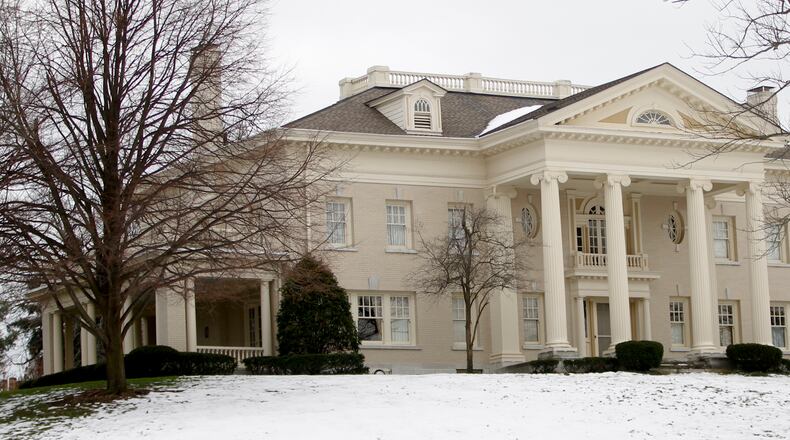Orville and Wilbur Wright, who lived and worked in Dayton in the late 1800s, are credited with inventing and building the world’s first practical airplane. They honed their mechanical skills by working on bicycles, printing presses and other machines, and spent four years testing their home-built kites, gliders and airplanes at Kitty Hawk, N.C. The Wrights completed their first sustained flight under power at Kitty Hawk on Dec. 17, 1903.
For the first time, descendants of the Wright Brothers are licensing their famous forebears' name and likenesses for consumer goods so they can support Hawthorn Hill — the Oakwood mansion where Orville Wright lived for decades.
“This house is our motivation,” said Amanda Wright Lane, great grandniece of Orville and Wilbur Wright, the Dayton brothers credited with inventing the first practical airplane.
The family struck licensing deals with media companies in the 1990s that helped the family support Dayton's Aviation Trail, Wright State University and aviation-related causes, Wright Lane said.
She hopes the new licensing strategy will generate the funds needed to support the 6,000-square-foot mansion, which is part of Dayton Aviation Heritage National Historical Park.
Operating and maintaining the mansion on its 3.4 acres requires $130,000 to $180,000 a year, said Mike Parks, Dayton Foundation president. In 2006, NCR Corp. returned the Harmon Avenue home to the Wright family following decades of NCR ownership. Today, the Dayton Foundation — of which the Wright Family Foundation is a part — owns the home.
“Our first priority is to make sure we’re able to perpetually maintain this wonderful asset that has been given to us,” Parks said. To do that, “we’re going to need to have a financing plan in order to carry out the family’s wishes.”
The foundation already has raised a little more than $1 million for the home through a permanent endowment at the Dayton Foundation, Parks said.
Supporting the home requires three “legs of the stool,” Park said — the national park, the endowment and this licensing strategy.
Wright Brothers brand possibilities today include associations with aviation or bomber jackets, aviation chronographs or watches, high-end clothing, sunglasses and more, Wright Lane and others involved in the strategy said. Much of the interest in Wright Brothers brand licensing originates in China and elsewhere in Asia, she said.
“I think some of the things we’re looking at are really classy,” she said.
A small Dayton marketing firm is spearheading the work. Visual Marketing Associates (VMA) is negotiating with possible licensees, including Chinese manufacturers. The Wright Family Foundation, a non-profit, licenses the merchandise rights to VMA, which acts as licensor.
VMA has been in business for more than 25 years, doing branding work for manufacturers like Mead, NewPage and Crown Equipment, and nations such as Colombia.
Kenneth Botts, Visual Marketing Associates principal, said he and the Wright family realize they must “guard” the brothers’ legacy. They likely would not agree, for example, to a Wright Brothers beer because the brothers did not drink alcohol.
Ohio's Great Lakes Brewing Co. recently offered a pilsner-style beer called "The Wright Pils." The bottles featured a label bearing an image of an early Wright Flyer airplane. The Wright family communicated with Great Lakes Brewing about the use of the Wright name, but took no legal action against the company, Wright Lane said. The brewer made a donation to the Wright Family Foundation, she said.
The Wright Family Foundation approached VMA with the licensing idea about 18 months ago, Botts said. “We were glad to accept that discussion, and put together a big plan for merchandising the Wright Brothers brand so there could be a revenue stream,” he said.
There are already licensing agreements with three companies, including Revell Inc., a maker of plastic model kits. Botts declined to name the other two businesses with whom VMA has agreements. Wright Lane declined to say how much revenue the deals have been generated so far.
Tracy Kizer, a University of Dayton marketing professor who teaches brand management, said relatives of famous people should be careful not to “flood” the market with images of their ancestors. That could destroy an air of “exclusivity” about the brand and leave consumers with a bad impression, she said.
“The Wright Brothers hold a very special place in the hearts of many Americans — and probably many people worldwide — and they’re not really associated with consumer goods right now,” Kizer said.
Botts said his company has been quiet about the agreement with the Wright family, but he sees a lot of potential.
“There are celebrities that are licensed all the time on products,” Botts said. “They could be prints on bed linens. It could be a manufacturer who wants to market bicycle parts. It could be Wright Brothers bicycle parts.”
Many historical photos of the Wrights are in the public domain. But the Wright family and VMA can “draw the line” when it comes to the use of the Wright Brothers name or image on consumer goods, Botts said.
About the Author

